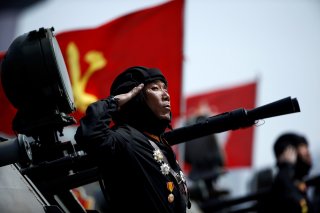Malcolm Davis

As these words are written, North Korea has halted the operation of the five-megawatt nuclear reactor at Yongbyon. This move is most likely intended to extract plutonium for weapons-grade enrichment and provide fissile material for more nuclear weapons. Late in September, North Korea amended its constitution to enshrine the goal of accelerating the production of nuclear weapons. Its focus remains on building up a significant force of strategic and tactical nuclear weapons. These, it claims, are meant for deterrence. Nevertheless, Pyongyang could easily employ them for compellence and coercion.
Pyongyang continues a series of missile tests for weapons suitable to deliver nuclear warheads against South Korea, Japan, and United States military forces in the Indo-Pacific region, as well as against the continental United States itself. It has also unveiled a new conventionally powered but nuclear-armed submarine designed to give it a basic second-strike capability.
The Biden Administration isn’t really engaged with Pyongyang, even indirectly, in discussions on achieving the goal of comprehensive and verifiable nuclear disarmament of North Korea. If Donald Trump regains the White House after the 2024 Presidential election, it is unlikely that he will make meaningful progress toward that goal. Moreover, there will be no restoration of personal summit diplomacy, especially after the failure of the 2019 Hanoi summit.
Finally, lingering concerns remain that Pyongyang could conduct a nuclear weapons test, mainly to perfect the design of tactical nuclear weapons. If Russia follows through with its implied threat to withdraw from the Comprehensive Test Ban Treaty and then tests a warhead, expect a North Korean test to follow soon after.
So what does this mean for North Korea’s future operational nuclear posture, and what are the implications for regional nuclear stability? Indeed, the nuclear dynamics will likely grow more dangerous and complex.
Of particular concern must be Pyongyang’s focus on tactical nuclear weapons designed for battlefield use on the Korean Peninsula. Pyongyang must recognize the growing qualitative conventional imbalance with the ROK and seek to rely on tactical nuclear weapons to counter the conventional military superiority of South Korean forces. But it’s also conceivable that Pyongyang could choose to use the threat of tactical nuclear weapons coercively in a crisis—much as Russia has done regarding NATO during the war in Ukraine while relying on its strategic nuclear forces to deter American retaliation.
Such a scenario would likely prompt South Korea to look at its own nuclear weapons option, with President Yoon having already hinted that a South Korean independent nuclear weapons capability has been considered. Yet, in a crisis, Seoul is unlikely to have time to build a bomb. The concern in Seoul now must be that a change of administration in Washington could raise uncertainty about American extended nuclear deterrence security guarantees to both Seoul and Tokyo. Pyongyang, perhaps backed by Russia, might exploit such a scenario to challenge U.S. strategic influence in northeast Asia and coerce Seoul.
In a future scenario of weaker U.S. extended nuclear deterrence security guarantees, South Korea would likely need to move quickly to get nuclear weapons to avoid becoming vulnerable to nuclear coercion from North Korea. This would need to be followed by a similar Japanese move.

From Beijing’s perspective, such a nuclear future would complicate its strategic outlook immeasurably. Still, it would also emphasize a need for Beijing to move more rapidly and preemptively in its own nuclear modernization and expansion efforts to encompass a greater emphasis on sub-strategic and even tactical nuclear weapons as part of a move away from the traditional “no first use” and “minimum deterrent” force posture of the People’s Liberation Army Rocket Force.
No comments:
Post a Comment